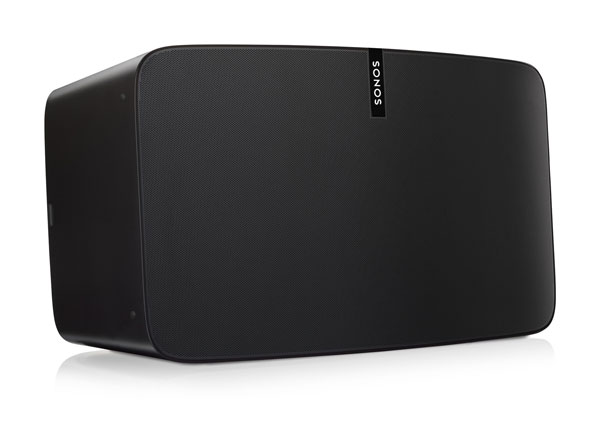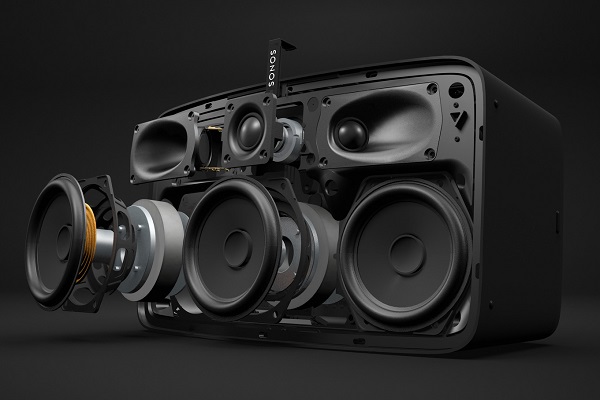
Despite a seemingly endless parade of new products and services entering the wireless home music arena, friends and family members who come to me in search of buying advice continue to get one recommendation more than any other: Sonos. With its continuously impressive PSI rating (performance per square inch - yes, I made that up) and a simplicity of operation that even my kids can understand, Sonos' attractive suite of powered PLAY speakers continues to be a perennial favorite. Only the original PLAY:5 (previously known as the ZonePlayer S5), when viewed next to its sleeker and younger PLAY:1 and PLAY:3 siblings, is starting to show any signs of aging. However, that all changes with the introduction of the completely redesigned PLAY:5, making its debut alongside TruePlay, Sonos' innovative, new calibration and room optimization software.
It's a Set-Up!
Unpacking the PLAY:5, it's immediately apparent that Sonos gives even the smallest details careful consideration. Whether it's the innovative, locking cardboard packaging or the efficiently-packed and handsome documentation or the speaker's custom-made, detachable power plug, Sonos knows that the ownership experience begins the moment you get the box home. From unboxing the PLAY:5 right on through its set-up and activation process, Sonos has gone out of their way to delight and surprise, removing the myriad minor (and sometimes major) annoyances and obstacles typically associated with the installation of a new gizmo.

Like the other PLAY speakers and components available within the SONOS product line, setup and control of the PLAY:5 requires a free download of the Sonos Controller application, available for Windows, Mac, Android, and iOS. If you already have a Sonos system in your home and you're simply adding a PLAY:5 to the mix, you can skip the download and add the PLAY:5 using the intuitive wizard in the Controller app you're already using. When instructed, adding the PLAY:5 to your system is as simple as pushing a button on the back side of the PLAY:5; a reassuring tone accompanies this act, letting you know that your PLAY:5 is ready to, well, play.
Why Sonos?
For those who are unfamiliar with how Sonos works, their excellent controller application makes possible a winning combination of local content (e.g. the iTunes library and playlists on your mobile devices, desktop or laptop) along with internet radio and streamed content from just about every music service under the sun: Pandora, Spotify, Rdio, Amazon Music, TuneIn, and Google Play Music to name a few. Even Apple Music is coming soon to Sonos, and that's a pretty big deal considering Apple's competitive AirPlay wireless streaming platform.
Using Sonos' exceptional controller app, Sonos owners can control what's playing in each zone and manage an integrated music queue which mixes local music with songs from any of the aforementioned streaming services. Taking things further, Sonos owners can route different queues or sources to different zones or synchronize them all so that all speakers are playing the same tune during a party. For example, a single PLAY:5 might become a zone called "Office," but I can easily "group" my Office PLAY:5 with the PLAY:3 in the Kitchen and the PLAY:1 speakers in the kids' rooms. Anyone with a Sonos app nearby can easly modify the groupings so it becomes fun for the whole family.
(True)Play Time
The launch of the PLAY:5 speaker is certainly exciting, but even if you're not planning to purchase one (yet), it's still a great time to be a Sonos system owner. That's because Sonos has just taken the wraps off TruePlay, its new room optimization EQ software. Let's face it: the place your speaker looks best or is most conveniently out of the way is rarely the place it also sounds best. Every room is different and sometimes you just can't avoid placing the speaker in a location that is, acoustically at least, less than ideal. Enter TruePlay. Using the microphone on your iOS mobile device, TruePlay generates a series of test tones to get a sense for your room, your speaker's location within the room, and the software then crunches the numbers and makes EQ adjustments (if needed) to make the speaker sound as good as possible in your unique space.
Before doing any critical listening, I tested TruePlay's capabilities by moving my PLAY:5 to the corner of my media room and queued up the Red Hot Chili Peppers' Otherside on Pandora. If you've ever placed your subwoofer in the corner, you know that room corners tend to amplify bass output - and not necessarily in a good way. As expected, the corner location made the PLAY:5's bass more boomy than I'd like and the overall sound quality took a hit as a result. After running through a TruePlay room tuning session, the bass was reigned in nicely and the PLAY:5 sounded more natural and balanced overall. Impressive.
TruePlay is currently available for iOS devices only, but Sonos is working on a way to bring it to Android. Apparently microphone quality and audio processing can vary greatly from one Android device to the next, so Sonos decided to start with iOS where there's a more reliable and consistent microphone in use across the iPhone and iPad product lines. As Sonos says on their website, "It's absolutely our intent to support Trueplay on Android so know we haven't lost sight of this gap and are quite unhappy about the lack of Android support." Also, since the TruePlay setup routine is something you only have to do once for each speaker (until you move the speaker, that is), you can probably find a friend or family member who will let you borrow their iPhone or iPad for the few minutes it takes to complete the optimization.
Take 5. Better Yet, Take Two.
Above I said you could take one PLAY:5 speaker and have that serve as your "Office" zone. That was indeed my first test. However, since Sonos also allows you to create a stereo pair using two PLAY:5 speakers, that was my second test. The software is smart enough to know that you already have one PLAY:5 in the system, so once you go to add a second one, it gives you the option of creating a stereo pair.
As I did in my review of the PLAY:1, I fired up Pink Floyd's "Money" and was instantly blown away by the full-bodied soundstage created by the two PLAY:5 speakers and the delicious separation of left and right that's only afforded by having two speakers. Like the PLAY:1, one PLAY:5 sounds great but two elevates things to an entirely different level. And unlike the PLAY:1, the PLAY:5 has a robust and convincing low end that makes the use of a subwoofer less of a necessity and more of an optional luxury for diehard audiophiles (but you can do that too if you like, by adding a Sonos sub). In short, the PLAY:5 sounds fantastic all by itself.
In addition to the lovely new enclosure on the redesigned PLAY:5, a welcome addition is the capacitive touch buttons on the top of the unit. Although I wasn't crazy about losing the physical rocker button to adjust volume, I eventually adapted to the new touch controls and I love that you can swipe from left to right to advance to the next track or swipe left to go to the previous track (where supported by the app). This is particularly useful when you're listening to Pandora or some other service that thinks it knows what you might like to hear next (or what you're not sick of hearing); sometimes they're just plain wrong. A simple swipe right skips to the next track, and all is right with the world. (Tinder users may be confused by this). Of course, since a software update in 2013, all Sonos speakers (including the original Play:5) can skip tracks with a double tap to what was previously the "mute" button, but this is the first Sonos product to also offer a previous track command.

Turn-Ons
Turn-Offs
Final Thoughts
Whether I was rocking out to the Raconteurs' "Steady, As She Goes" or sipping wine to Nina Simone's "Feeling Good" -- a song I'm ashamed to admit I didn't discover until it was used oh so brilliantly in NBC's "Chuck" -- the Sonos PLAY:5 never failed to impress me with its clear highs, rich, full-bodied midrange, and a surprisingly detailed low end. And man can they play loud! I had a pair of PLAY:5 speakers going while listening to "Feeling Good" and it's safe to say I was listening at an unhealthy volume; the PLAY:5 was completely up to the challenge and seemed eager for more.
At $499, the PLAY:5 is not an impulse buy. For a single speaker, it's a buying decision that warrants some serious thought. However, when you consider just how good the PLAY:5 sounds - especially relative to its modest footprint - and add in the fun and potential of a Sonos whole house system, coupled with the fact that you won't need to add external amplification or a subwoofer, the PLAY:5 makes a rather compelling case for itself. Highly recommended.
Manufacturer's Specifications
What's in the Box?
More Information
Where to Buy:
| Overall | |
|---|---|
| Value | |
| Performance | |
| Features/Ergonomics |